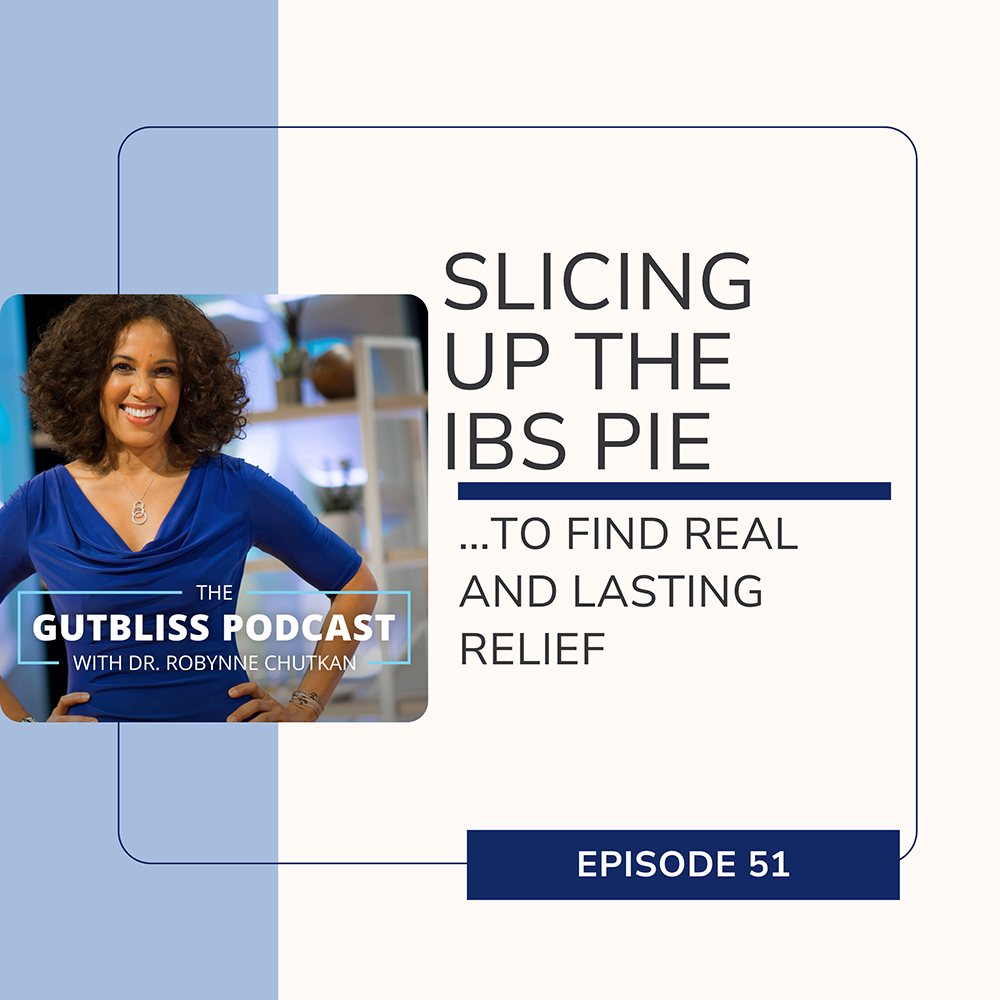There are 3 categories of bowel habits: Ironman bowel actions that are so timely and precise you can literally set your clock to their arrival; couch potato bowel actions that are always late and sometimes stand you up altogether and don’t even arrive; in between bowel actions that are generally pretty good but could be better. In this episode I’m going to tell you how to have Ironman BMs.
Thank you for being a part of our community! For the latest in digestive wellness go to https://gutbliss.com/ and follow us on Instagram for more gut health info.
On today’s show, true story about an encounter in the emergency room almost 20 years ago. It’s 1996, and I’m a GI fellow at Mount Sinai Hospital in New York when I get a message on my pager – yes, my pager; we were still using those then. The message says: “fecal impaction in ER needs GI evaluation”. If you’re wondering what a fecal impaction is and if it’s as bad as it sounds. I’m going to explain what it is, and I also want to tell you that yes, it is as bad as it sounds. Both for the person who’s impacted and for the person doing the disempaction, who at that moment – since I was holding the pager – happened to be me.
A fecal impaction occurs when someone gets so constipated that the stool in their rectum hardens and basically turns into concrete – (we actually describe it as “fecal concretions”) – and the GI evaluation they were requesting in the ER was just a nice way of saying: get down here and dig all of this hard stool out of this person’s bottom. It’s sort of a rite of passage when your team is called to the ER for a fecal impaction – usually in a constipated elderly patient from a nursing home – that as the lowest ranking person on the team, you end up being the disempactor. So of course I immediately start looking around for the medical student or intern, but alas, both the intern and medical student on our team were in the endoscopy suite watching procedures, and I just didn’t have the heart to pull them away for this. So the next thing I start looking around for is a constipated elderly patient from a nursing home. But when I get to the stretcher of the patient I’m supposed to be evaluating, I see what appears to be a 30-something year old man, and he is built! He introduces himself as Adam and he could literally pose for an anatomy textbook – every muscle is honed and defined and for sure he has single digit body fat. He has an Ironman tattoo on his arm that I immediately recognize because I am obsessed with the Ironman. Anybody else obsessed with doing an Ironman? Glutton for 140.6 miles of punishment? Fast forward now from 1996 to 2012, when I signed up to be a medical volunteer at the Ironman championship in Kona, Hawaii. Competing at Kona is on my bucket list, but I’m not quite there – okay, I’m not even close, and volunteering was my best option for getting to Kona. I was really curious to see what it would be like to swim 2.4 miles, bike 112 miles, and then run 26.2 miles. In 100 degree heat. The year I volunteered, Pete Jacobs of Australia won the men’s division and Leanda Cave of England won the women’s. And just to put it in perspective for what kind of effort is involved. Pete Jacobs’ overall time for winning the Ironman that year was around 8 hours and 18 minutes. And his marathon finish time was 2 hours and 48 minutes, which means that after swimming 2.4 miles and biking 112 miles, he then ran a full marathon (26.2 miles) at about a 6 and a half minute mile pace. In 100° heat. I was there working in the medical tent when those first elite athletes came in, people like Pete Jacobs and Leanda Cave. And I can tell you that these are people at the peak of physical performance. They do not look like the rest of us. Coming up – I’m going to tell you about Ironman bowel movements; what they are, and how to get them. My observation – inspired by the Ironman championship in Kona, is that there are three kinds of people: über-athletes like the Ironman competitors; couch potatoes; and everybody in between. With bowel habits there are also 3 categories:
- Ironman bowel actions that are so timely and precise you can literally set your clock to their arrival
- Couch potato bowel actions that are always late and sometimes stand you up altogether and don’t even arrive
- In between bowel actions that are generally pretty good but could be better
Which kind of bowel habits you have (Ironman, couch potato, or in between) is ALSO related to your physical activity — although fortunately it doesn’t take swimming, cycling, and running for 140.6 miles to have timely bowel movements, and, of course, there are additional factors beyond exercise that affect bowel activity.
But here’s what I want you to remember: your digestive tract is one long muscle, and if you’re not moving enough, there’s a good chance your bowels won’t be either. We know that runners actually have better bowel movements: not as hard, bigger, and more frequent. So let’s talk about that inner workout that’s going on inside you:
Your intestines are made-up of muscles that propel and mix digested food as it travels through your GI tract. This muscular movement is called “peristalsis”, and it consists of wavelike motions as the muscles contract and relax. Your intestinal muscles are arranged in layers: circular muscles alternating with longitudinal ones. Contraction of the circular muscles initiates peristalsis, and then the longitudinal muscles provide the propulsion. So you have an initial contraction, and then forward motion. It’s the exact same mechanism that earthworms use to move around.
Now, unlike our biceps or hamstrings, which are skeletal muscles under voluntary control (we can decide when we want to move them) – our intestinal muscles are smooth muscles, and they are under involuntary control. But despite the fact that peristalsis occurs without our effort or consciousness, our level of physical activity has a huge impact on the muscular contractions of our gut. In fact, exercise is one of THE most important stimulators of peristalsis. And there are 3 mechanisms for how that works:
- Exercise speeds up transit time through your digestive tract so that your stools arrive at their final destination faster
- Gravitational forces at work during exercise help to propel your stool downward towards your rectum
- Exercise increases production of nitric oxide, a chemical that relaxes the smooth muscles of your digestive tract and helps to speed up peristalsis
So faster transit time, gravity to help move things in the right direction, and nitric oxide to activate the intestinal muscles. These are all key ingredients if you’re trying to have Ironman bowel movements.
Speaking of Ironman, let’s go back to 1996, emergency room, GI evaluation. Given what I’ve just told you, how is it possible that this Ironman Adonis, Adam, has a fecal impaction? He should be having Swiss watch precision bowel movements.
<p”>I lift up the sheet covering Adam on the stretcher and ask him to turn on his left side to begin my disempaction when I notice an important clue: he’s wearing a soft boot. He tells me he twisted his ankle running trails and tore 3 ligaments, and he’s been sidelined now for about 6 weeks – unable to run, bike, or swim. Exercise was Adam’s foolproof way to keep things moving – literally. Adam also had a history of serious depression, and he had been prescribed a type of antidepressant called an SSRI (selective serotonin reuptake inhibitor). SSRIs can be very constipating, and the anti-depressant had really slowed down Adam’s bowel movements. But once he took up triathlons and started working out regularly, the exercise had helped his mood so much that he was able to get off the SSRI (with the help of his doctor, of course). And once he was off the SSRI, his bowel movements improved dramatically, and he was no longer constipated. Since getting injured he wasn’t able to exercise, and his depression had gradually returned, and he ended up back on the SSRI and super constipated once again. Plus, Adam told me he usually drank about 3 liters of water when he was training. So here was this perfect storm of no movement, a very constipating medication, and much less hydration. And I’m going to circle back to hydration in a minute
Ok, this all sounds great, but what about the downside? From a GI point of view, are there any hazards associated with exercise that you should know about? Intense exercise for long periods of time – think Ironman training – has been known to cause nausea, diarrhea, and, rarely, gastrointestinal bleeding because so much blood is being shunted to large muscles like your hamstrings or quadriceps, and not enough to your intestines, but these symptoms are usually with very extreme exercise and may even be considered protective by forcing you to slow down or stop if you’re overdoing it.
If you ask me what kind of exercise you should be doing, I’ll tell you that just like there are no bad vegetables, there really are no bad forms of exercise. Some are more dangerous, or require more skill or fancy equipment, but I can’t think of any that I would recommend you avoid, assuming you’re hydrating and fueling properly, listening to your body, warming up, etc. I’m a yogi and a (slow) runner, so I’m going to focus a little bit more on how those forms of exercise can be helpful with getting your bowels moving.
For anyone who’s ever done a downward-facing dog, the gastrointestinal benefits of yoga are not hard to believe. Yoga is sort of a twofer: it can relieve stress as well as the actual physical symptoms of many digestive disorders. That’s in part due to the strengthening of your core abdominal muscles, which help to bind your intestines in place and prevent bulging and bloating. The belly breathing techniques in some forms of yoga can provide pain relief, and the twisting poses can help improve gas and constipation. Gas tends to get trapped in two places along the digestive tract: the left upper corner of the abdomen, where the spleen can press on the bowels, and the right upper corner, where the liver can do the same thing. Poses that involve twisting at the waist can help to disperse those gas pockets and relieve pressure.
Studies also show that yoga can raise levels of the feel-good hormone serotonin, and decrease stress-related hormones like cortisol, improving both mood and symptoms.
If you read through the psychiatric literature, you’ll find a lot of articles about long-distance runners getting depressed when they stop running. But if you examine this phenomenon carefully, what becomes clear is that for many of those athletes, it’s not the absence of exercise that’s causing their depression; it’s the presence of exercise that’s treating it. Many people have consciously or subconsciously figured out that running and other forms of exercise improve their mood and keep their depression under control. I’ve seen the same phenomenon in runners who develop constipation and bloating after an injury sidelines them. A daily run had been their foolproof guarantee of satisfaction in the bathroom and a bloat-free existence. So their “stool nirvana” is very much tied to their exercise routine. That was definitely the case with Adam.
Running burns about 100 calories every ten minutes, assuming a ten-minute-per-mile pace. For most of us, that will also cause us to sweat—a great way to remove toxins via what I like to think of as your external GI tract—your skin. When we sweat, we tend to drink more water. More water is one of the fundamental rules for stool nirvana: it improves gut motility, lymphatic flow, stool consistency, and bowel regularity. If you’re good about replacing all the fluids you’ve lost (plus a little extra), running – or really any form of exercise – can translate to extra hydration, which is great for your bowel movements.
It turns out exercise is also really good for your microbiome. A British study compared stool samples from professional rugby players to those of healthy men of the same age who weren’t avid exercisers. The athletes’ stool samples had more bacteria, greater species diversity, and significantly higher levels of the species that are associated with low rates of obesity. You don’t need to be a professional rugby player to benefit from the microbe-boosting effects of exercise. Just elevating your heart rate to 20 percent above baseline with a brisk walk for thirty minutes three to five times a week is enough to stimulate peristalsis, which is important for maintaining a healthy microbiome.
I want to leave you with 3 takeaways about exercise and your digestive tract:
- If you’re not moving, neither are your bowels. It doesn’t matter whether you walk, run, ride, swim, or hop around on one leg…..just get moving! If you want to have Ironman bowel movements that are timely and precise, you need to do everything you can to increase your gut motility – and that means lots of movement.
- The medicine cabinet can be a major source of constipation. Prescription drugs, over the counter remedies, and supplements can all contain ingredients that slow down gut motility, so if your bowel movements tend to be on the sluggish side, don’t forget to discuss your medications with your prescribing physician.
- Exercise is good. Exercise plus hydration is better. But if you really want to experience stool nirvana, try Exercise plus hydration plus a high-fiber diet.
So that’s it for this edition of the Gutbliss Podcast on how to have Ironman bowel movements.









